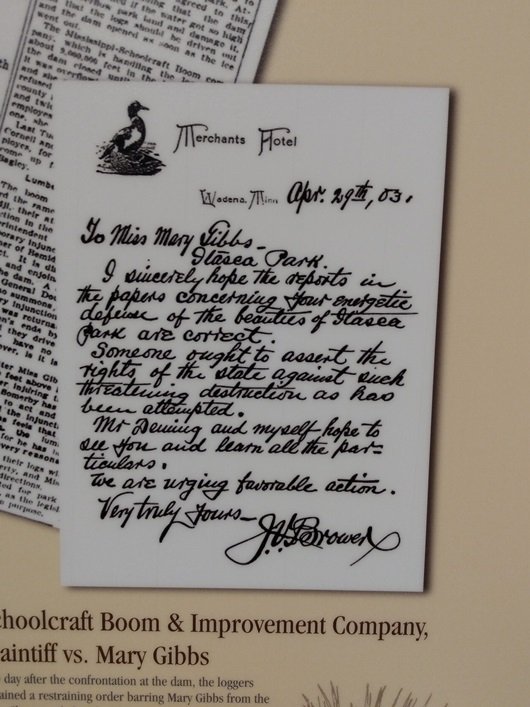Mary Gibbs
Samuel Rinnah Van Sant was a very interesting guy. Under his father's tutelage, he built an extremely successful lumber transport company in Minnesota. It was said of him, “His innovations revolutionized transportation on the Mississippi River.” He then became active the state political scene when he was elected to the Minnesota State House of Representatives. He served as a Congressman for the state for two terms, from 1893 to 1897, and was Speaker of the House during his second term. His political career culminated with his service as Governor of the state from 1901 to 1905.
Mary Hannah Gibbs was the Superintendent of Itasca State Park, the 32,000-acre park that encompasses the Mississippi River headwaters in Minnesota. Itasca was voted into existence in 1888 by the state legislature, making it Minnesota's first and oldest state park and the second-ever state park in the entire nation. The park itself and the multiple discoveries of the Mississippi's headwaters are complex topics for another day's discussion, but understand that there was a legitimate reason for wanting to protect what Mother Nature provided within its boundaries. Mary Gibbs enters Itasca's story in 1901, when her father John Gibbs was appointed park Superintendent. Mary, the second-youngest of John's nine children and the youngest daughter, was still living in the family home, so Itasca became her home too.
Mary initially served as park secretary. It is unclear if this was actually a paid, titled position or if she was just helping her dad. Considering the lumber interests almost stymied the creation of Itasca State Park (with one fewer vote in the state legislature, the park would have never come to be), it seems unlikely that a job of secretary would have been created. That same legislature only allotted a paltry $21,000 for all expenses, including road and building construction and administrative operating capital. This legislature was comprised of, and loyal to, lumber-industry businessmen, and they really weren't going to go out of their way to make Itasca State Park a success. With all that being said, it seems highly unlikely that “secretary” was an established job in the park structure, and equally unlikely that Mary was paid for her work.
When John Gibbs died in 1903, lumber-shipper Governor Van Sant asked Mary to serve as interim Superintendent of Itasca State Park. She was asked to serve because, they said, it would be impossible to find a new candidate in the winter months. Ostensibly, this was a reward for all her hard work as secretary. Ostensibly, this was because she already had extensive knowledge of the park's inner workings and therefore was the only legitimate choice for the job. So, Mary Gibbs, at the tender age of 24, became nation's first female state park superintendent. This fact is bandied about by women as a feel-good, hear-me-roar moment in women's history. It might even be a “Jeopardy!” answer. Reality check, here, please. There were a total of two, only TWO, state parks in the entire country (the first and only other state park was Niagara Falls, New York). It's not like this was some old boys' club of hundreds of members and Mary broke through the glass ceiling. She was shifted into the superintendent's position because nobody in state government cared about the place, and the failure they had hoped for seemed more imminent with a woman-child running the place. I mean, who better to bend to the will of the big, strong lumber boys than a silly 24-year-old woman, who still lived at home and was dumb enough to actually think her job was important, right?
Wrong. Oh, so very wonderfully, amazingly WRONG!
Itasca State Park has beautiful old-growth white and red pine forests, and the establishment of state park boundaries was designed to protect these forests and the headwaters of the Mississippi River from future exploitation and destruction. But the timber itself and the Mighty Mississippi as a means to transport it to the mills and lumber exchanges of Minneapolis were just too lucrative for King Lumber to let go. With Mary in charge, the scene is set for easy pickin's.
Mississippi Schoolcraft Boom and Improvement Company got a special legislative pass to build a dam within the boundaries of Itasca State Park. The idea is that low-level flooding expands their ability to float their timber (low cost) instead of portage their timber (high cost) to access the running water of the Mississippi River near its beginning. But give them an inch, and they'll take more inches. The company continued to allow the water to rise beyond the established acceptable limit. The excess water building up behind the dam meant that the old-growth forests were beginning to die. And this pissed Mary off.
Mary was, no doubt, truly upset at the death of the trees, but the real venom in her came from the fact that she was sworn to uphold the law protecting the park, and King Lumber wasn't following the rules. She sent official letters to Mississippi Schoolcraft Boom and Improvement Company, demanding that they meet the conditions of their permit, and was ignored. She sent official letters to Governor Van Sant, and was ignored. She wrote letters to her direct boss, the state Attorney General, saying, “The water in the lake is now about 20 inches above high water mark, and it is rising from one to two inches per day … If the gates of the dam are not raised the lake shores will be ruined.” Still, nobody cared. She went next to her local sheriff. Itasca State Park sits in three adjacent counties, and Mary chose the sheriff in whose county the dam was actually located. She showed the sheriff the legislative permit issued to the lumber company, pointed out the specific flood-level allowed, and told him exactly how far above that amount they had already gone. Mary and the sheriff went to the dam site together, with a warrant, and Mary set about opening the dam. The lumber boss actually pointed a rifle at Mary, saying that he would shoot the hand of anyone who touched the dam's levers. Mary responded something like, “I dare you.” That's obviously not a direct quote, but it is certainly the idea she got across when she told the lumber boss she was, in fact, going to open those gates herself and he was, in fact, NOT going to shoot her. However, in a somewhat comical ending to such high drama, she wasn't physically strong enough to operate the levers and literally couldn't open the flood gates. But with the sheriff and other witnesses there, the lumber boss backed down and opened the gates himself. The water behind the dam was released, and the sheriff arrested the lumber boss and one other employee.
The story continues with Governor Van Sant more-or-less abdicating authority to the District Attorney in quite the Pontius Pilate move. An injunction was issued to prevent future over-flooding. The lumber industries fought the District Attorney and fought the injunction, garnering several small victories along the way. Their biggest victory came was injunction of their own barring Mary from any further intrusion on their business practices. However, the real victory is much easier to see. Mary Gibbs' putting her personal safety on the line, just doing her job that critical day, saved Itasca State Park, and by extension the old-growth forest and the Mississippi River headwaters, for future generations. End of story.
Mary involuntarily retired from her position less than two months later. King Lumber, who originally thought she was weak and malleable, now stood against her. Governor Van Sant likely never intended to appoint her to her own permanent position anyway. She was relieved of duty when her boss, the District Attorney during all this mess, was given the permanent appointment as Superintendent of Itasca State Park. Mary and her widowed mother left the park and lived in a rented apartment in Minneapolis until her mother's death in 1904. In the space of nine short months, Mary had lost her father, her job and her home, and her mother. She then moved to Alberta, Canada to be nearer her older sister. She married William Logan there, and went on to a wonderful life with her husband and four children on fifty-plus acres. At age 93, Mary staged a protest in her nursing home. Residents of the home were levied a twenty-five cent delivery fee if they chose to eat their meals in their rooms instead of in the common dining area. As a direct result of Mary's hunger strike, the fee was eliminated. In 1983, at the incredible age of 104, Mary Gibbs Logan passed away.
Minnesota folk singer Charlie Maguire did extensive research on Mary, including unearthing her official correspondence and interviewing her descendants. The 1991 song he wrote about her inspired Governor Jesse Ventura to name the new visitor center, completed in 2005, after our heroine. I personally have visited the Mary Gibbs Mississippi Headwaters Center in Itasca State Park. In 2020, Maguire told the Minneapolis' Star Tribune that in 1903, when Theodore Roosevelt and John Muir were merely discussing how to preserve natural places, “there was already a woman in Itasca State Park doing it, at the risk of her own life.”


